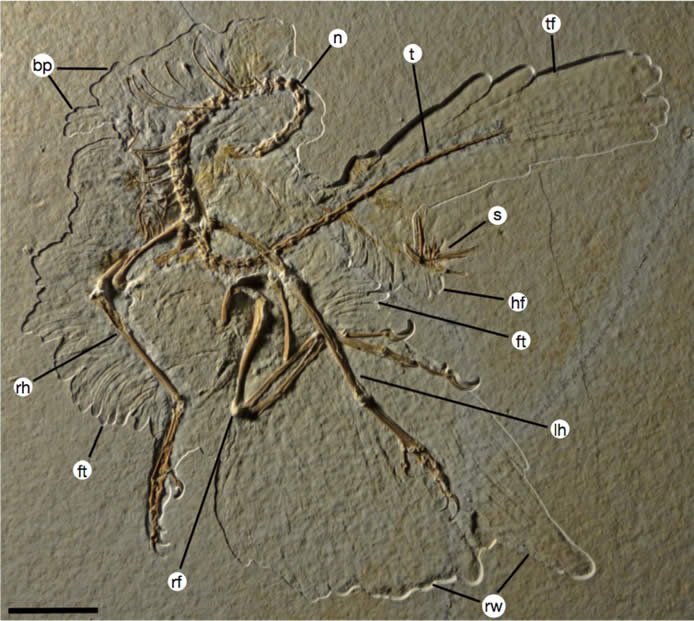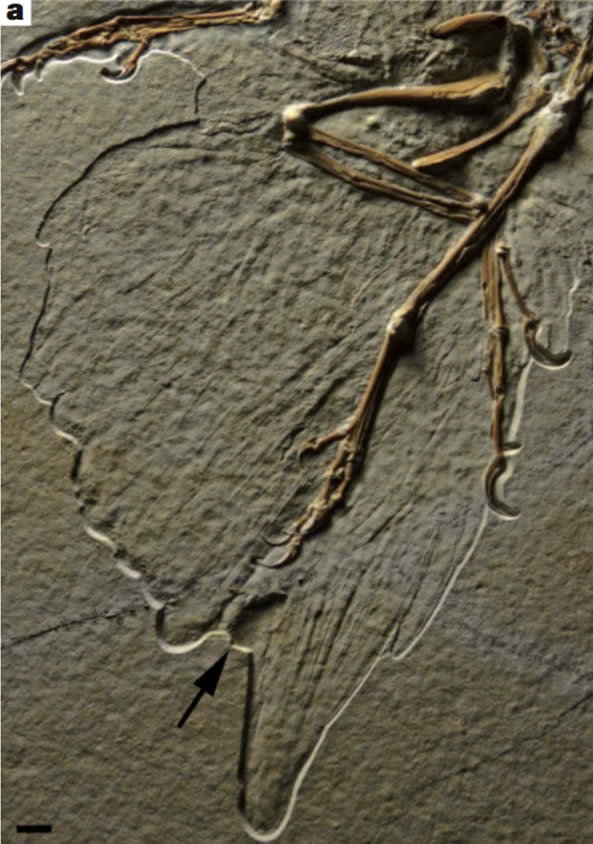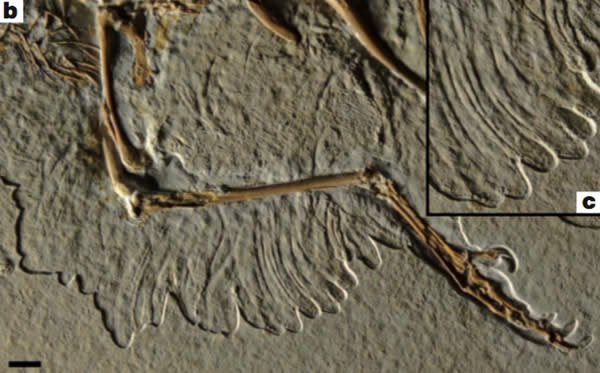
Archaeopteryx’s Feathery Legs Fuel Flightless Evolutionary Claims
News to Know
Abstract
This bird wore britches, but why? evolutionists ask.
News Source
Archaeopteryx, an extinct bird represented by at least eleven distinctly feathered fossils, definitely had mature-appearing flight feathers on its legs. In fact, analysis of the eleventh known specimen of Archaeopteryx reveals that, in addition to its leg feathers, its wings, tail, body, and neck were feathery—like today’s birds. Additionally, analysis of its well-preserved wing feathers supports the oft-questioned position that this feathery bird was able to achieve lift and fly. While there is nothing “transitional” about the feathers on Archaeopteryx, researchers report these “feather trousers”1 have given them insight concerning the evolution of pennaceous (quill-like) feathers.
Feather Legs
Eighteen long leg feathers in the fossil are oriented perpendicular to the bird’s hindlimb (tibiotarsus). There is also an additional row of shorter feathers preserved near the ankle and upper part of the foot. Unlike the asymmetrical flight feathers of the wings and tail, these leg feathers are symmetrical. The feathers flying birds use to achieve lift have an asymmetrical shape—a thin stiff leading edge cutting through the air and a longer more flexible trailing edge providing a wide surface for airflow, which is adjusted as the bird tilts the feather-bearing structure.
The authors of the report in Nature explain further:
More than 18 feathers are preserved along the right tibiotarsus; they are arranged mainly in parallel and preserved with their long axes oriented almost perpendicularly towards the tibiotarsus. The narrow vanes are fully symmetrical in shape, and seem to expand slightly towards their distal end, although this might be an artefact due to overlapping in the more basal parts. As in the body feathers, the rhachides are slightly curved. In the region of the right ankle and proximal metatarsus, a row of very short (about 25% of the length of the feathers on the mid-length of the tibiotarsus), narrow-vaned, symmetrical feathers is preserved.3
This is the eleventh known specimen of Archaeopteryx. It has some of the best-preserved quill-like feathers in the Archaeopteryx fossil record. In addition to robust flight feathers on its wings (as seen in photograph “a”), it also has lots of quill-like feathers preserved parallel to its legs and upper feet. (These “feather trousers” are best seen perpendicular to the tibiotarsus bone in photograph “b” and magnified in “c.”) The fossil also has feathers associated with its neck, body, and tail. [Abbreviations: ft=“feather trousers”; rh=right hindlimb bones; rf=right forelimb bones; rw=right wing; hf=hackle feathers; bp=body plumage; n=neck; s=all that’s left of its skull; t=tail; tf=tail feathers; Scale bar = 5 cm (full fossil); 1 cm (a,b). Images by C. Foth et al., via Nature.2 Tap each image to view larger version.
What’s a Feather for?
The function of the leg feathers is uncertain, as there are no living specimens around to show us how Archaeopteryx used them. The flight feathers on the wings of flying birds are asymmetrical in shape, which facilitates lift. Thus it would not be reasonable to consider these symmetrical leg feathers to be an extra set of wings in the ordinary sense. That is not to say that the leg feathers could not have facilitated the bird’s flight however. Some argue that the overlapping arrangement of the feathers may have had contributed to the animal’s aerodynamic competence. And of course there is also the possibility that the feathers are not preserved in the same position they occupied in life. Though the feathers are preserved perpendicular to the bone, that position may simply be the result of the crushing and sudden burial that doubtless is responsible for the exquisite preservation of this fossil.
Modern birds with feathers on their legs—like hawks and eagles—use them for stabilization during landing.
The researchers from the Bavarian State Collection for Palaeontology and Geology at Ludwig Maximilians University in Munich, Germany, suggest these leg feathers could have evolved for mate-attracting displays, camouflage, or insulation. Certainly feathers can serve all of these purposes on living birds, but assuming that the feathers had to evolve for some non-aerial purpose is an evolutionary presupposition.
Modern birds with feathers on their legs—like hawks and eagles—use them for stabilization during landing. The research team, however, believes these leg feathers demonstrate that feathers first evolved for non-aerial purposes and were later adapted to flight in various lineages of birds as well as in lines of birds that are commonly classified by evolutionists as dinosaurs.
Flapping or Flightless or Something in Between?
Scientists have long debated whether Archaeopteryx could fly. While Archaeopteryx clearly had mature flight feathers on its wings, many aspects of Archaeopteryx anatomy differed from that of modern birds. Archaeopteryx had teeth, for instance. Its fossils lack a keel, but if its breastbone was made of cartilage, it simply might not have been preserved.
Could Archaeopteryx fly? Well, the flight feathers on its wings were asymmetrical, like those that modern flying birds have on their wings and tails. Aerodynamically, this asymmetry helps a feather function as an airfoil (a curved surface that aids in lift, like an airplane’s wing) and improves lift. The question of Archaeopteryx aeronautical capabilities has remained up for debate, however, because the central shaft of the wing feathers on other fossil specimens seem thin—too thin, in the estimation of some, to withstand the stress of flapping.4
The analysis of this fossil helps settle the flight question, as the shafts on this specimen’s wing feathers are clearly seen and appear quite sturdy. “The remiges [flight feathers] of the new specimen of Archaeopteryx show robust rhachides [central shafts],” the authors write, “indicating that recent studies assuming limited flight ability in Archaeopteryx and basal birds based on the relative rhachis [shaft] diameter might be in error owing to the poorer preservation quality of the feathers measured.”5 Because these well-preserved feathers confirm the central shaft of each feather was not flimsy after all, it seems that the Archaeopteryx wing feathers would have been able to tolerate the forces produced by flapping. “I'm pretty sure it could fly,” says paleontologist and author Oliver Rauhut, “though of course there is still a debate about how well it could fly.”
Dr. Rauhut leans toward mating display as the most likely evolutionary purpose for the leg feathers. He believes that feathers evolved in parallel for flightless purposes in many creatures. “Given the great diversity of pennaceous feathers found within different body regions and across the phylogeny,” the authors write in Nature, “it seems plausible that the evolution of this feather type (especially in the wing, hindlimbs and tail) was primarily driven by display functions.”
Evolutionary History of Feathers?
What they discovered from this exercise was that they were unable to trace the evolution of feathers.
In order to draw conclusions about the evolution of pennaceous feathers, Rauhut and colleagues mapped out the presumed evolutionary relationships of various extinct animals with clear fossil evidence of flight feathers, including birds recognized as birds and others officially classified by evolutionists as dinosaurs with feathers. By comparing the body locations of fossilized feathers on these animals as well as the feathers’ characteristics, they believe they have established the historical evolutionary trajectory of pennaceous feathers. But what they discovered from this exercise was that they were unable to trace the evolution of feathers. The phylogenetic patterns they expected were not there. Therefore, they concluded that pennaceous feathers evolved multiple times: “The origin and evolution of flight in theropod dinosaurs were more complex than previously thought.”6
Furthermore, since evolutionary patterns for feather evolution were not evident, the researchers decided that feathers must have evolved for non-flight purposes, as flight is such a complicated thing, and that feathers were later adapted for flight in animals that evolved the ability to fly:
Pennaceous body feathers were certainly important for body insulation. However, these feathers may have further been used for camouflage and display. Furthermore, elongated remiges [flight feathers] on the forelimb were probably used for balance during locomotion and breeding. . . . This feather type probably fulfilled several biological roles related to body insulation, manoeuvrability, brooding, camouflage and display. However, given the great diversity of pennaceous feathers found within different body regions and across the phylogeny, it seems plausible that the evolution of this feather type (especially in the wing, hindlimbs and tail) was primarily driven by display functions.7
Commenting on the report, paleontologist Nick Longrich of the University of Bath, United Kingdom, disagrees. He believes it more likely the leg feathers collectively served an aerodynamic role. Longrich says, “I think they’re airfoils. . . . They're really long, they overlap the same way flight feathers do, and the fact that they curve is a characteristic flight feather feature.”8
What Is Archaeopteryx?
Archaeopteryx has been the topic of many debates in evolutionary circles. Bird or dinosaur? “Proto-bird” or transitional form? The first bird to evolve or a latecomer? Able to take off or limited to gliding? Evolving the ability to fly or completely flightless? A prototype for analyzing the origin of bird flight, or an insignificant bystander? Last year we even reported on an evolutionist’s presentation asserting Archaeopteryx evolved flight and then lost it. Others have proposed the bird could fly as a juvenile and then lost the ability as it matured.
Evolutionary scientists have generally considered Archaeopteryx a transitional form since its discovery in 1876. In recent years, evolutionists have debated back and forth whether to classify this bird as a bird or a dinosaur. (Of course, for evolutionists committed to calling all birds “avian dinosaurs,” the dilemma seems to vanish.) Though nothing like an Archaeopteryx is alive today, its unusual anatomical features—teeth and claws on its wings—are not unheard of in more “conventional” birds. For instance, while no living birds have teeth, the extinct Hesperornis had teeth. And while the birds in most of our backyards lack claws on their wings, some living birds do have wing digits and claws. The juvenile hoatzin of South America has claws on both its thumb and first finger and uses them to climb trees. The adult ostrich has also has two fingers on each wing.
Because Archaeopteryx has anatomically demonstrable pennaceous (quill-like) feathers, we know it is a bird.
Because Archaeopteryx has anatomically demonstrable pennaceous (quill-like) feathers, we know it is a bird. There is no reason it should be considered a transitional form other than the evolutionary need to find transitional forms. Moreover, ornithologists—even evolutionary ones—generally consider Archaeopteryx to be a bird. Nothing in biology demonstrates how organisms can obtain the genetic information to transition into new, more complex creatures nor any verifiable mechanism by which something as complex as flight feathers could evolve through natural processes. The feathers on this specimen are designed like the feathers of modern birds and do not reveal any evolutionary progression.
Bird Origins
Whether Archaeopteryx was able to fly or not is an aerodynamic question, not an evolutionary one. God created many kinds of birds that would have been fully fitted out with feathers and the abilities and anatomy that suited the habitats and lifestyles for which He designed them. While evolutionists insist that flightless birds evolved from flying ancestors, this is a purely evolutionary assumption, and the features that make many birds flightless are good designs that suit them for their lifestyles and the niches they occupy. Penguins, for instance, are perfectly designed as diving seabirds and have solid bones from their deepest known representatives in the fossil record to penguins living today. It is also possible that some birds may have been designed to fly but over time lost that ability, yet that scenario has nothing to do with evolution into a new, more complex kind of animal. It will be interesting to see whether aerodynamic modeling or further fossil discoveries reveal more about the evidently exquisite aerodynamic design of the Archaeopteryx.
God created all kinds of birds on the fifth day of Creation Week about 6,000 years ago, and He created the land animals (which would have included dinosaurs) the next day. Based on God’s statements recorded in Genesis, we can infer that He created these animals to reproduce “after their kinds.” Biologically, we can observe that animals do just that, varying within their created kinds. Nothing about this discovery supplies an evolutionary mechanism for feathers or for birds. It does, however, further illustrate God’s design for this unusual (by modern standards) extinct bird.
Further Reading
- Did Archaeopteryx Evolve Flight and Then Get Grounded?
- Is the Dawn of the Early Bird Too Good To Be True?
- Dinosaur-Bird Confusion
- Were Birdbrains on the Dinosaur Pre-flight Checklist for Evolution?
- Do Four-Winged Birds Confirm Dinosaur Role in Flight Evolution?
- Seabird Study Said to Solve the Evolutionary Mystery of Flightlessness
- Do Tacked-on Chicken Tails Tell How T-rex Walked?
- The Evolution of Feathers: A Major Problem for Darwinism
- An Initial Estimate of Avian Ark Kinds
For More Information: Get Answers
Remember, if you see a news story that might merit some attention, let us know about it! (Note: if the story originates from the Associated Press, FOX News, MSNBC, the New York Times, or another major national media outlet, we will most likely have already heard about it.) And thanks to all of our readers who have submitted great news tips to us. If you didn’t catch all the latest News to Know, why not take a look to see what you’ve missed?
(Please note that links will take you directly to the source. Answers in Genesis is not responsible for content on the websites to which we refer. For more information, please see our Privacy Policy.)
Footnotes
- C. Foth et al., “New Specimen of Archaeopteryx Provides Insights into the Evolution of Pennaceous Feathers,” Nature 511, no. 7507 (2014): 79, doi:10.1038/nature13467.
- Ibid.
- Ibid.
- Dr. Janice Hughes, “But Could Archaeopteryx Fly?” Aves Vitae, February 6, 2012, http://www.avesvitae.org/avesvitae/News/Entries/2012/2/6_But_Could_Archaeopteryx_Fly.html.
- Foth et al., “New specimen.”
- Ibid.
- Ibid.
- Tim Wogan, “Flight May Have Evolved Multiple Times in Birds,” Science, July 2, 2014, http://www.sciencemag.org/news/2014/07/flight-may-have-evolved-multiple-times-birds.
Recommended Resources

Answers in Genesis is an apologetics ministry, dedicated to helping Christians defend their faith and proclaim the good news of Jesus Christ.
- Customer Service 800.778.3390
- © 2024 Answers in Genesis







